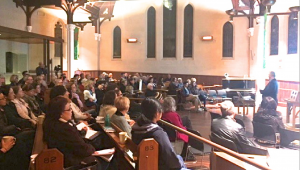It was an honour to be the August 2016 guest speaker at the Jungian Society of Melbourne, presenting on my book, Synchronicity: Empower your life with the gift of coincidence (click here for full video). I was struck by the ongoing interest in Jung’s concept of synchronicity given that he developed his ideas about it from about 100 years ago. He based his ideas partly on his conversations with Einstein about relativity and time.
Many consider the notion of synchronicity to be pre-scientific, or superstitious, because the term implies that remarkably uncanny and meaningful coincidences result from more than mere chance. Ironically, however, it was another leading scientist of the time, Wolfgang Pauli, who helped bring synchronicity to the world’s attention. He did so by encouraging Jung to write about it by offering to co-author a book with him that would detail Jung’s views on synchronicity.
When people experience marked synchronicity it can seem like a form of miracle energy. It is often associated with fortuitous events, personal discoveries, meaningful connections with others and an uplifting sense of being guided toward one’s destiny. I wrote on this subject as a mainstream psychologist to encourage others to acknowledge their own sacred and mystical experiences.
Such experiences are too often dismissed as not being rational enough to be fully acknowledged or meaningfully interpreted. Our Western culture tends to dismiss phenomena that cannot readily be explained in rational terms. We often act as though these phenomena to do not exist, however meaningful they may be in a person’s lived experience.
In western psychology, most forms of transpersonal and psychic phenomena are still treated as mere superstition. Modern psychology is limited, and indeed impoverished, by its lack of attention to spiritual and transpersonal phenomena. It is not as if such experiences are not relevant to people’s lives. On the contrary, as emphasized by the psychologist, Ken Pargament, many people’s lives are profoundly influenced by sacred moments.
Sacred moments may be indelibly printed in our minds, as strongly as the trauma memories of those suffering from post-traumatic stress. As Pargament highlights, such moments are like “un-PTSD” incidents, having just as much impact on our lives, but in an uplifting way. They can be most powerful in affirming our life direction, enhancing our sense of life purpose and meaning. Fortunately, there seem to be some early signs that western psychology is starting to be a little more open to acknowledging a spiritual dimension to life, based on the influence of those such as Ken Pargament.
In my book I describe many of my clients’ and my own experiences of sacred moments that manifested in the form of synchronistic experiences. One involved a client’s encounter with a black bird that saved his life by smashing into a window pane he was kneeling in front of, just as he was about to pull the trigger of a pistol placed in his mouth. The black bird’s dramatic intervention was such an “un-PTSD” incident. My client will never forget it. Nor will I, having heard about it. It was numinous. It was archetypal. It was a miracle in his life. However, he would never have told me of this compelling incident which saved his life and shifted him to a purposeful and satisfying future, had he not known that I was writing a book on synchronicity. He previously thought I might have dismissed him as crazy if he told me that story.
I now say to other psychotherapists that if you are not hearing at least some stories like this, it is most likely because your clients are not telling you about them. They will censor their un-PTSD moments – their sacred moments – because they will not seem sufficiently rational to confide. We are only likely to hear of others’ mystical, psychic or transpersonal experiences if we are open to a transpersonal dimension ourselves. What I have found is that it is only since I have been more ready to tell others of my own transpersonal experiences and beliefs that I have regularly heard of them from others. My own experience as a therapist, and that of many of my clients in therapy, has become so much richer.
For Chris’s Psych Spiels podcast episodes on synchronicity, click here (ep. 24) and here (ep. 25). His short videos on synchronicity are available here.
– Chris Mackey is a Fellow of the Australian Psychological Society and is the principal psychologist at Chris Mackey and Associates, with 40 years’ psychotherapy experience. He received the 2019 Australian Allied Health Impact Award for his clinical research and media work.
The Positive Psychology of Synchronicity (2nd edition of Chris’s book) was released in August 2019.
The new edition also refers to updated web-based materials including information and mental health tips at the Resources page at our practice website, at the book’s website (www.www.synchronicityunwrapped.com.au) and at the Chris Mackey Psychology YouTube channel.

